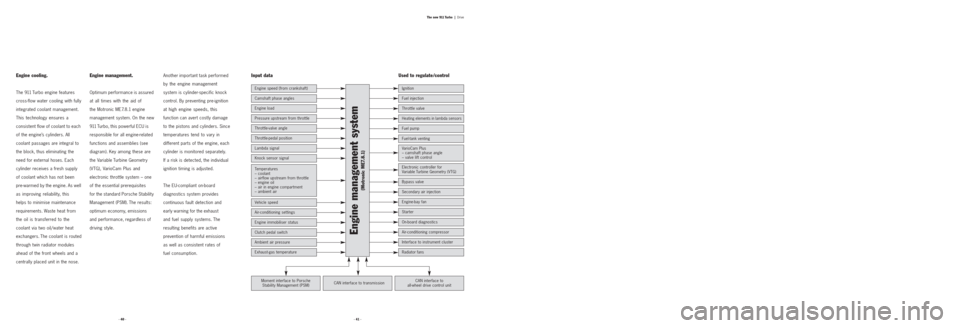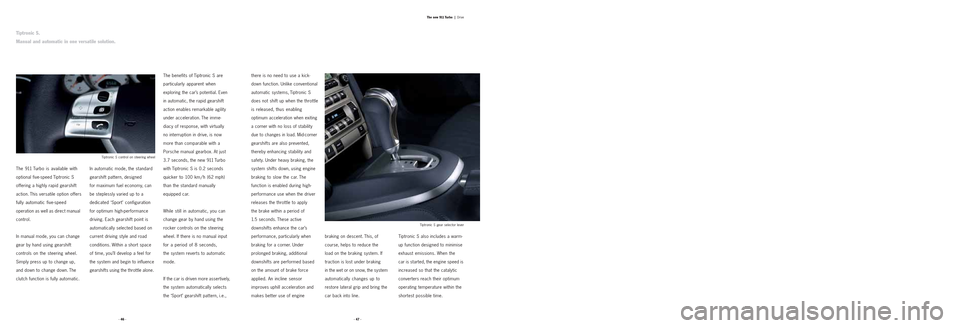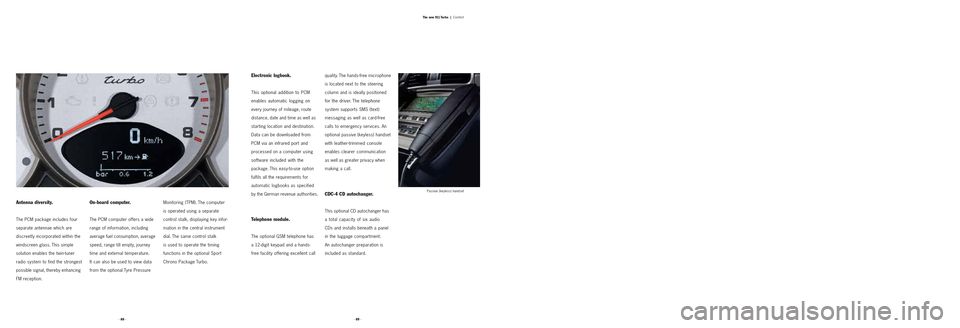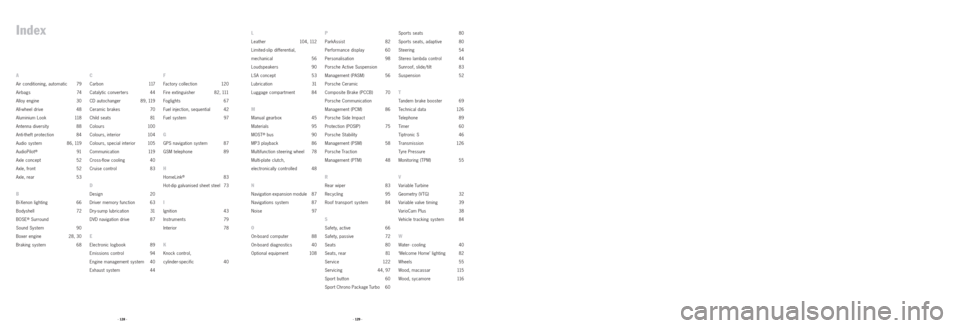change time PORSCHE 911 TURBO 2004 4.G Information Manual
[x] Cancel search | Manufacturer: PORSCHE, Model Year: 2004, Model line: 911 TURBO, Model: PORSCHE 911 TURBO 2004 4.GPages: 61, PDF Size: 2.14 MB
Page 16 of 61

Engine cooling.
The 911 Turbo engine features
cross-flow water cooling with fully
integrated coolant management.
This technology ensures a
consistent flow of coolant to each
of the engine’s cylinders. All
coolant passages are integral to
the block, thus eliminating the
need for external hoses. Each
cylinder receives a fresh supply
of coolant which has not been
pre-warmed by the engine. As well
as improving reliability, this
helps to minimise maintenance
requirements. Waste heat from
the oil is transferred to the
coolant via two oil/water heat
exchangers. The coolant is routed
through twin radiator modules
ahead of the front wheels and a
centrally placed unit in the nose.
Engine management.
Optimum performance is assured
at all times with the aid of
the Motronic ME7.8.1 engine
management system. On the new
911 Turbo, this powerful ECU is
responsible for all engine-related
functions and assemblies (see
diagram). Key among these are
the Variable Turbine Geometry
(VTG), VarioCam Plus and
electronic throttle system – one
of the essential prerequisites
for the standard Porsche Stability
Management (PSM). The results:
optimum economy, emissions
and performance, regardless of
driving style.Another important task performed
by the engine management
system is cylinder-specific knock
control. By preventing pre-ignition
at high engine speeds, this
function can avert costly damage
to the pistons and cylinders. Since
temperatures tend to vary in
different parts of the engine, each
cylinder is monitored separately.
If a risk is detected, the individual
ignition timing is adjusted.
The EU-compliant on-board
diagnostics system provides
continuous fault detection and
early warning for the exhaust
and fuel supply systems. The
resulting benefits are active
prevention of harmful emissions
as well as consistent rates of
fuel consumption.
· 40 ·· 41 ·The new 911 Turbo |
Drive
Input data Used to regulate /control
Engine management system
(Motronic ME7.8.1)
Engine load
Pressure upstream from throttle
Throttle-valve angle
Engine speed (from crankshaft)
Camshaft phase angles
Throttle-pedal position
Lambda signal
Knock sensor signal
Ignition
Fuel injection
Throttle valve
Heating elements in lambda sensors
Fuel pump
Fuel-tank venting
CAN interface to
all-wheel drive control unit CAN interface to transmissionMoment interface to Porsche
Stability Management (PSM)
VarioCam Plus
– camshaft phase angle
– valve lift control
Electronic controller for
Variable Turbine Geometry (VTG)
Bypass valve
Secondary air injection
Engine-bay fan
Starter
On-board diagnostics
Air-conditioning compressor
Interface to instrument cluster
Radiator fans
Vehicle speed
Air-conditioning settings
Engine immobiliser status
Clutch pedal switch
Ambient air pressure
Temperatures
– coolant
– airflow upstream from throttle
– engine oil
– air in engine compartment
– ambient air
Exhaust-gas temperature
Page 19 of 61

Tiptronic S also includes a warm-
up function designed to minimise
exhaust emissions. When the
car is started, the engine speed is
increased so that the catalytic
converters reach their optimum
operating temperature within the
shortest possible time. braking on descent. This, of
course, helps to reduce the
load on the braking system. If
traction is lost under braking
in the wet or on snow, the system
automatically changes up to
restore lateral grip and bring the
car back into line. there is no need to use a kick-
down function. Unlike conventional
automatic systems, Tiptronic S
does not shift up when the throttle
is released, thus enabling
optimum acceleration when exiting
a corner with no loss of stability
due to changes in load. Mid-corner
gearshifts are also prevented,
thereby enhancing stability and
safety. Under heavy braking, the
system shifts down, using engine
braking to slow the car. The
function is enabled during high-
performance use when the driver
releases the throttle to apply
the brake within a period of
1.5 seconds. These active
downshifts enhance the car’s
performance, particularly when
braking for a corner. Under
prolonged braking, additional
downshifts are performed based
on the amount of brake force
applied. An incline sensor
improves uphill acceleration and
makes better use of engine
The 911 Turbo is available with
optional five-speed Tiptronic S
offering a highly rapid gearshift
action. This versatile option offers
fully automatic five-speed
operation as well as direct manual
control.
In manual mode, you can change
gear by hand using gearshift
controls on the steering wheel.
Simply press up to change up,
and down to change down. The
clutch function is fully automatic.In automatic mode, the standard
gearshift pattern, designed
for maximum fuel economy, can
be steplessly varied up to a
dedicated ‘Sport’ configuration
for optimum high-performance
driving. Each gearshift point is
automatically selected based on
current driving style and road
conditions. Within a short space
of time, you’ll develop a feel for
the system and begin to influence
gearshifts using the throttle alone.
The benefits of Tiptronic S are
particularly apparent when
exploring the car’s potential. Even
in automatic, the rapid gearshift
action enables remarkable agility
under acceleration. The imme-
diacy of response, with virtually
no interruption in drive, is now
more than comparable with a
Porsche manual gearbox. At just
3.7 seconds, the new 911 Turbo
with Tiptronic S is 0.2 seconds
quicker to 100 km / h (62 mph)
than the standard manually
equipped car.
While still in automatic, you can
change gear by hand using the
rocker controls on the steering
wheel. If there is no manual input
for a period of 8 seconds,
the system reverts to automatic
mode.
If the car is driven more assertively,
the system automatically selects
the ‘Sport’ gearshift pattern, i.e.,
· 46 ·· 47 ·The new 911 Turbo |
Drive
Tiptronic S gear selector lever Tiptronic S control on steering wheel
Tiptronic S.
Manual and automatic in one versatile solution.
Page 24 of 61

The new 911 Turbo is equipped
with Porsche Active Suspension
Management (PASM) as standard.
This electronic active damping
system offers continuous adjust-
ment of the damping force on
each wheel based on current road
conditions and driving style.
PASM has two driver-selectable
setup modes, ‘Normal’ and ‘Sport’,
which share a minimal degree
of overlap. While ‘Normal’ provides
a blend of performance and
comfort, the ‘Sport’ setup mode
has a much firmer range of
settings. The system responds to
changing road conditions and/or
driving style by continuously
varying the individual damping
forces within the parameters
defined for the selected setup
mode (‘Normal’ or ‘Sport’).
PASM uses a range of sensors
to monitor any movement in the
body of the car (e.g., under
acceleration, braking or on uneven
road surfaces). The PASM control
unit uses this data to obtain a
real-time evaluation of the forces
acting on the car. The system
responds continuously with a
corresponding modification of
individual damping force s in
accordance with the selected
setup mode. The results are a
reduction in both pitch and roll
as well as consistent road-holding
from all four wheels.
If ‘Sport’ mode is selected, the
suspension is set to a harder
damper rating. If the quality of
the road surface falls below a
certain threshold, the system
immediately changes to a softer
rating within the ‘Sport’ setup
range. This adjustment enhances
occupant comfort as well as
traction and grip. When the road
surface improves, PASM
automatically reverts to the
original, harder rating.
If ‘Normal’ mode is selected, and
the car is driven more assertively,
PASM automatically switches to
a harder rating within the ‘Normal’
setup range. As the dampers
become stiffer, the car becomes
more stable, ensuring higher
levels of active safety as well as
greater enjoyment from your
Porsche.
Limited-slip differential.
The manual gearbox version of
the new 911 Turbo is available with
an optional mechanical limited-slip
rear differential. Key benefits
include greater rear-end traction
when exiting hairpin bends as
well as on variable-grip surfaces.
It also compensates for changes
in wheel loads caused by throttle
modulation when cornering.
· 56 ·· 57 ·The new 911 Turbo |
Chassis
Porsche Active Suspension Management (PASM).
From ultimate comfort to optimum performance,
all at the push of a button.
Rebound in ‘Normal’ mode –
damper piston with bypass
valve openRebound in ‘Sport’ mode –
damper piston with bypass
valve closed
Compression in ‘Sport’ mode –
damper piston with bypass
valve closedCompression in ‘Normal’ mode –
damper piston with bypass
valve open
Page 40 of 61

Antenna diversity.
The PCM package includes four
separate antennae which are
discreetly incorporated within the
windscreen glass. This simple
solution enables the twin-tuner
radio system to find the strongest
possible signal, thereby enhancing
FM reception.
On-board computer.
The PCM computer offers a wide
range of information, including
average fuel consumption, average
speed, range till empty, journey
time and external temperature.
It can also be used to view data
from the optional Tyre PressureMonitoring (TPM). The computer
is operated using a separate
control stalk, displaying key infor-
mation in the central instrument
dial. The same control stalk
is used to operate the timing
functions in the optional Sport
Chrono Package Turbo.
Electronic logbook.
This optional addition to PCM
enables automatic logging on
every journey of mileage, route
distance, date and time as well as
starting location and destination.
Data can be downloaded from
PCM via an infrared port and
processed on a computer using
software included with the
package. This easy-to-use option
fulfils all the requirements for
automatic logbooks as specified
by the German revenue authorities.
Telephone module.
The optional GSM telephone has
a 12-digit keypad and a hands-
free facility offering excellent callquality. The hands-free microphone
is located next to the steering
column and is ideally positioned
for the driver. The telephone
system supports SMS (text)
messaging as well as card-free
calls to emergency services. An
optional passive (keyless) handset
with leather-trimmed console
enables clearer communication
as well as greater privacy when
making a call.
CDC-4 CD autochanger.
This optional CD autochanger has
a total capacity of six audio
CDs and installs beneath a panel
in the luggage compartment.
An autochanger preparation is
included as standard.
· 88 ·· 89 ·The new 911 Turbo |
Comfort
Passive (keyless) handset
Page 59 of 61

L
Leather 104, 112
Limited-slip differential,
mechanical 56
Loudspeakers 90
LSA concept 53
Lubrication 31
Luggage compartment 84
M
Manual gearbox 45
Materials 95
MOST
®bus 90
MP3 playback 86
Multifunction steering wheel 78
Multi-plate clutch,
electronically controlled 48
N
Navigation expansion module 87
Navigations system 87
Noise 97
O
On-board computer 88
On-board diagnostics 40
Optional equipment 108
P
ParkAssist 82
Performance display 60
Personalisation 98
Porsche Active Suspension
Management (PASM) 56
Porsche Ceramic
Composite Brake (PCCB) 70
Porsche Communication
Management (PCM) 86
Porsche Side Impact
Protection (POSIP) 75
Porsche Stability
Management (PSM) 58
Porsche Traction
Management (PTM) 48
R
Rear wiper 83
Recycling 95
Roof transport system 84
S
Safety, active 66
Safety, passive 72
Seats 80
Seats, rear 81
Service 122
Servicing 44, 97
Sport button 60
Sport Chrono Package Turbo 60Sports seats 80
Sports seats, adaptive 80
Steering 54
Stereo lambda control 44
Sunroof, slide/tilt 83
Suspension 52
T
Tandem brake booster 69
Technical data 126
Telephone 89
Timer 60
Tiptronic S 46
Transmission 126
Tyre Pressure
Monitoring (TPM) 55
V
Variable Turbine
Geometry (VTG) 32
Variable valve timing 39
VarioCam Plus 38
Vehicle tracking system 84
W
Water- cooling 40
‘Welcome Home’ lighting 82
Wheels 55
Wood, macassar 115
Wood, sycamore 116
· 129 ·
A
Air conditioning, automatic 79
Airbags 74
Alloy engine 30
All-wheel drive 48
Aluminium Look 118
Antenna diversity 88
Anti-theft protection 84
Audio system 86, 119
AudioPilot
®91
Axle concept 52
Axle, front 52
Axle, rear 53
B
Bi-Xenon lighting 66
Bodyshell 72
BOSE
®Surround
Sound System 90
Boxer engine 28, 30
Braking system 68
C
Carbon 117
Catalytic converters 44
CD autochanger 89, 119
Ceramic brakes 70
Child seats 81
Colours 100
Colours, interior 104
Colours, special interior 105
Communication 119
Cross-flow cooling 40
Cruise control 83
D
Design 20
Driver memory function 63
Dry-sump lubrication 31
DVD navigation drive 87
E
Electronic logbook 89
Emissions control 94
Engine management system 40
Exhaust system 44
F
Factory collection 120
Fire extinguisher 82, 111
Foglights 67
Fuel injection, sequential 42
Fuel system 97
G
GPS navigation system 87
GSM telephone 89
H
HomeLink®83
Hot-dip galvanised sheet steel 73
I
Ignition 43
Instruments 79
Interior 78
K
Knock control,
cylinder-specific 40
· 128 ·
Index